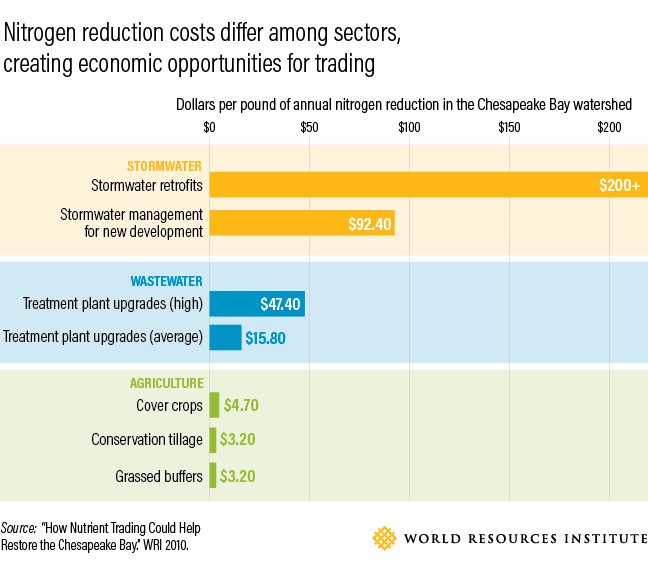On February 6, the U.S. Environmental Protection Agency (EPA) released a memorandum affirming this administration’s strong support for the use of market-based mechanisms like water quality trading to reduce pollution in U.S. waters. This support came at the request of the trading community — but there are many details to unpack.
Water quality trading is a mechanism that can incentivize quicker and more cost-effective pollutant reductions by allowing entities to purchase pollutant reductions from other sources. A wastewater treatment plant, for example, may find substantial new reductions in nutrient pollution to be expensive and technologically difficult. Trading would allow a wastewater treatment plant to pay for pollution reductions at a nearby farm, where equally beneficial interventions are cheaper.
The EPA hadn’t updated their policy on water quality trading for 15 years. This memo encourages states and tribes to “develop robust and defensible water quality trading programs,” and lays out six principles to help spur creativity. WRI has been studying and helping to support water quality trading for more than a decade. While the EPA’s reaffirmation of the importance of water quality trading is crucial, our research shows that more can be done to help this practice take off.
To Spur Trading, We Need Caps
EPA’s new memorandum suggests that water quality trading programs “can operate independent of or in coordination with the EPA’s traditional regulatory programs.” While true in theory, time and time again WRI and other leading experts have demonstrated that a strong regulatory driver—like a cap on nutrient discharges from a sewage treatment plant—works best for maximizing demand. Incentives to reduce pollution stimulate the market for purchasing offsets, ensuring an active trading program. Water quality trading is most effective not as an alternative to regulations but rather as a tool for adhering to regulations with more flexibility and cost-effectiveness.

Improving Water Quality Must Remain at The Forefront
EPA encourages greater “creativity and innovation in the implementation of market-based pollutant reduction programs” to spur increased activity in trading programs. Program developers should keep in mind that improving water quality, not increasing the volume of trades, is the ultimate goal. Creativity and flexibility should be bounded by the circumstances of the watershed to ensure each trade advances progress toward meeting water quality goals. Trading to meet a regulatory cap, for example, may necessitate stricter rules around the prerequisites to participate than trading to meet a voluntary goal.
To help program developers understand what’s appropriate for their watershed, the National Network on Water Quality Trading, an expert group of more than a dozen diverse organizations, including WRI, representing agriculture, wastewater utilities, environmental groups, regulatory agencies and water quality trading program practitioners, created comprehensive guidance on program design. Recognizing that there is no one-size-fits-all situation, Building a Water Quality Trading Program: Options and Considerations walks developers of new trading programs through an efficient and effective decision-making process grounded in the Clean Water Act and years of expertise.
3 Ways to Remove Barriers to Water Quality Trading

Stormwater on a street in Annapolis, Maryland. Flickr/Chesapeake Bay Program
There’s more EPA can do to help support “robust and defensible water quality trading programs.” The National Network on Water Quality Trading conducted a comprehensive assessment of barriers to demand. After more than a year of research, including more than 50 stakeholder interviews, they identified an action plan for increasing demand which includes three ways EPA can advance water quality trading:
1. Work with state regulatory agencies to clarify acceptable approaches to quantifying pollutant load reductions. Because nonpoint source pollution, like runoff from farm fields, is hard to directly measure, trading programs often rely on estimations of varying complexity. Developing these methods can be technically complex and resource-intensive. Program administrators would welcome guidance from EPA on acceptable methods.
2. Assist state regulatory agencies that want to design and implement trading programs. Sometimes, trading activity is depressed not due to lack of interest but due to a lack of staff capacity. EPA has experts on water quality trading who would be invaluable to states and other interested program administrators who lack the expertise, capacity or financial resources to develop a program from scratch.
3. Issue a policy statement in support of stormwater trading. Of all sources of nutrient pollution, reducing pollutants in stormwater is the toughest and most expensive. WRI estimates that reducing a pound of nitrogen from stormwater runoff by retrofitting old infrastructure could cost hundreds of dollars. On the other hand, it only costs $1 to $5 per pound to reduce nitrogen from agricultural land using practices like grass buffers. The cost savings of water quality trading are clear. Moreover, stormwater pollution continues to grow in many watersheds as other sectors make progress. If cities dealing with stormwater management could purchase pollutant reductions from other sectors, such as agriculture, to help meet their commitments, there is enormous potential to reduce loads more cheaply and quickly than would be possible with traditional approaches alone. However, there has been no national guidance on stormwater trading design, including in this recent memo. EPA could dramatically alter the water quality trading landscape as we know it by providing policy on stormwater.
When done right, water quality trading has the potential to catalyze cost-effective improvements in water quality. With water quality in the U.S. under threat, we need robust and urgent action on nutrient management. The National Network on Water Quality Trading’s resources can help program developers design robust, effective programs. And by providing greater certainty around trading policy, including stormwater, and providing technical assistance to help practitioners develop their programs, EPA can further promote this flexible and cost-effective tool for helping to meet water quality goals.



